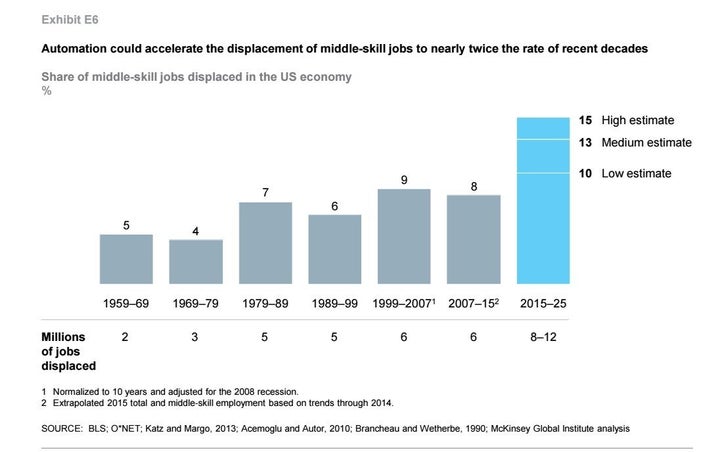The trends are clear: In 2017, we're going to be more connected on more devices creating more data than ever in human history. But what does that mean for us? And what does it mean for the economy? According to a new report from the McKinsey Global Institute, some people and companies are benefiting enormously from the digitization of America. And some people... are being left behind.
"What those at the frontier have, from companies to consumers, is a much better grasp of what's available or what can be done," Sree Ramaswamy, a senior fellow at McKinsey's research arm, told The Huffington Post last week.
"There are some institutions, industries, consumers and workers that are doing a lot better," he went on. "They are seeing disproportionate gains -- and we see a gap between 'haves' and 'have-mores,' which runs counter to a narrative of 'haves' and 'have-nones.'"

The challenge with this sort of research is that there's no single, standard definition of what it means to be "digitized." In fact, McKinsey used 27 different ways to measure "digitization" for its research.
"Some of it is about having a smartphone or broadband connection or a computer," Ramaswamy said, "but it's much more than owning an asset. Can you pay online? Can you transact with customers? Can you make transactions with other customers? Can you do work differently, using tech to automate the task?"
McKinsey sees the same thing on the consumer side.
"We've all got smartphones," Ramaswamy said. "But how many people know apps about using time more effectively or to make transactions online? Or how to maximize the ability to get discounts on different kinds of things?"
Plenty of sophisticated technology exists. The critical issue is whether companies, schools and individuals are in a position to make the most of it.
That's where this all comes back to people. McKinsey's research confirms that the digital gap at the individual level is tied to income and education. While the vast majority of the country now has some kind of access to the Internet, 15 percent of U.S. citizens still don't use the Internet at all, which means that millions of people are being left behind.

"It's not just about whether I have a broadband connection or smartphone, but the different ways I can use these new tools," said Ramaswamy. "You can call it digital awareness or digital literacy."
Outside of the boardroom, the key point this research drives home is that while regional and economic disparities in broadband Internet access persist across the country, the most important digital divide that's growing is in our understanding of what's possible. That, in turn, has an impact on social mobility.
"We have examples of what a worker would do differently [given access to modern tech]," Ramaswamy said. "Digital platforms are much better for figuring out potential employment options. If you are going out to learn, platforms will tell you about what skills will get you what returns, what employers want them and where to get those skills."
As the on-demand economy expands into more industries, these kinds of skills will be crucial for people hoping to find new opportunities as more and more workers are displaced through efficiency and automation.
"As a worker, I can find other assets, in terms of my time or talent, that I can use to generate a secondary income stream in addition to my job," Ramaswamy said. "We are not all going to become freelancers, so whether in terms of talent platforms or asset efficiencies or better matching or skills upgrading, we need to do better."
This is a challenge that's going to land on the next president's desk in January 2017, as software starts eating into white-collar jobs in the 21st century the way advanced manufacturing affected blue-collar jobs last century. McKinsey's conservative projection of jobs displaced by automation in the U.S. economy over the next decade is 10 million workers.
That means it's up to policymakers and elected leaders to help the people getting left behind by the rapid pace of technological change to learn how to make the most of search engines, social media, mobile phones and platforms for labor and talent.

